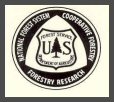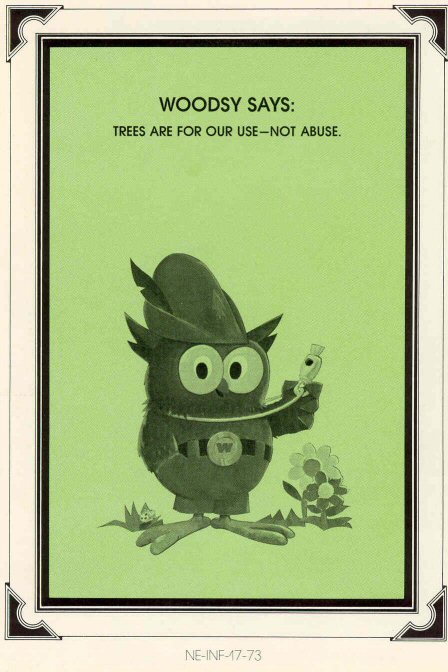
[Note from the web master. The word heal may be used here to describe the closure of a wound or a shed branch . Dr. Shigo now calls it closure and not healing. That and other terms, such as vigor verses vitality, can be found at www.treedictionary.com for your use. John A. Keslick , Jr.]
WOUNDED
TREES
MAR
OUR
ENVIRONMENT

This booklet is a part of a series of Informational material produced by the Forest Service to provide information on the wise use and care of trees,.. our most versatile and renewable natural resource.
Others in the booklet series include: "A tree hurts, too!': and "Your tree's trouble may be you:'
The information is based on the research work of Dr. Alex L. Shigo, a Forest Service Plant Pathologist. Illustrations are by David M, Carroll.
Cover - Wounded trees are hazards along our beautiful modern highways. Decaying trees also mar the beauty of scenic roadways.
Page 1
Wounded trees do mar our environment!
Awareness of a problem is the first step toward solution. The illustrations in this booklet show some of the wounds we are most likely to find on trees-if we look closely-that can cause serious damage to the trees.
By recognizing tree wounds, we may be able to spot an early trouble sign for the tree.
By being aware of tree troubles we can help trees improve our environment.
The better we are at detecting tree wounds, the better we can prevent and control decay- the major cause of damage to all species of trees throughout the world.
Page 2
Wounded Trees and Decay
What's the Problem?
WOUNDS on trees expose healthy wood to infection by microscopic organisms-bacteria and fungi. The diseases these organisms cause can lead to wood decay. Wound diseases can occur in all species of trees, and decay is a major problem throughout the world. Decay leads to weakening of branches, trunks, and roots. As decay develops, strong and beautiful trees are reduced slowly but surely to unsightly hazardous trees.
The microorganisms that cause wood decay grow unseen by us through wood exposed by wound. Often the decay associated with wounds is not noticed until it is too late. A decayed branch or tree falls on a person, power line, automobile, or house during a storm. A beautiful yard, street country road, park, or recreation area slowly loses the beauty that the healthy trees provided. The wood from a forest tree is discarded as waste after it goes through the sawmill.
Page 3
The problem is DECAY associated with wounds!
What can be done?
• PREVENTION
First: Greater care must be taken to prevent wounds. Too many people take trees for granted, and they think that no matter What they do to a tree, it will continue to grow. Trees, like all living things, will withstand only so much injury before they begin to weaken. Small wounds may not seem serious, but the accumulation of many small wounds over many years may odd up to serious trouble.
• HELP
Second: Help the tree help itself after wounding.
Remove the
obviously injured bark and wood.
Remove dead and dying branches.
Fertilize and water properly.
And remove less valuable trees and shrubs that may be
crowding the injured tree.
• REMOVE
Third: when wound diseases progress to the point where the tree, or its limbs may fall, or when the tree becomes unsightly; remove the tree, (A professional arborist can help you make this decision)
• PLAN
Fourth: When planting new trees, take time and plan ahead so that you will not as likely accidentally wound the growing tree. (For example trees should be planted away from driveways, curbs and walk-ways.)
Page 4
Tree Wounds found near a Rural Home In Early Summer
1 Open basal wound and large dead branches above.
2. Large dead branches; one over house roof.
3. Wound at base and large dead branch above
4. Large open wound and dead branch.
5. Open basal wound.

Page 5
Tree
Wounds found in a City in Winter1. Broken top.
2. Recently inflicted basal wound.
3. Open basal wound.
4. Broken and dying large branch.
5 Broken branch with new shoots.
6. Open trunk wound.
7. Open basal wound.

Page 6
Tree Wounds found in a Recreation Area in Early Spring
1. Dead top.
2. Large broken branch.
3. Open basal wound.
4. Basal wound, dead branches, and poorly healed branch stubs. 5. Dead branches
and poorly healed branches.
6. Decayed stump.

Page 7
Tree Wounds found in a Forest in Fall
1. Sapsucker wounds.
2. Root wounds.
3. Old open basal wound.
4. Recently inflicted high trunk logging wounds.
5. Old poorly healed stem stub.
6. Recently inflicted logging wounds.
7. Root wounds.

Page 8
Tree Wounds found near an Urban Home in Late Spring
1. Root wounds.
2. Fruit body of a fungus indicating advanced decay.
3. Decayed center stem.
4. Open stem wound.
5. Broken branch.
6. Old. stump. showing hollow center caused by decay.

Page 9
Tree Wounds found in a City Park in Late Summer
1 Dead branch.
2. Tan bark.
3. Broken large branch and fruit bodies of a fungus.
4. Small broken branches on large living branch.
5. Large and old branch stub with fungus fruit body.
6. Large trunk wound and bark wounds.
7. Fruit body of fungus, indicating advanced decay.
8. Root wounds.

Page 10
Properly prune a large branch and shape a trunk wound
1. Undercut to prevent splitting.
2. Uppercut to remove large branch.
3. Cut remaining branch stub flush with trunk.
[Note from web master. We are not to make flush cuts any more,
unless we are trying to make cavities for small wildlife. Look up Branch
Collar at www.treedictionary.com .
In fact one should read the World Wide Pruning Guide for a more complete
and accurate account for pruning branches. It can be found here
http://www.treedictionary.com/DICT2003/TPRUNING.html ]
4. Trunk after removal of branch.
5. Healed branch wound.
6. Mechanical wound on trunk.
7. Shape wound with a sharp knife.
8. Formation of vigorous callus tissue.
9. Closure of wound with callus tissue.

Page 11

Page 12
As our Nation grows, people expect and need more from their
forests-more wood; more water, fish and wildlife; more recreation and natural
beauty; more special forest products and forage. The Forest Service of the
U.S. Department of Agriculture helps to fulfill these expectations arid needs
through three major activities. ,
1. Conducting forest and range research of over 75 locations ranging from Puerto Rico to Alaska to Hawaii.
2, Participating with all state forestry agencies in cooperative programs to protect, improve and wisely use our Country's 395 million acres of State, local, and private forest lands.
3. Managing and protecting the 187-mitlion acre, National Forest System.
The Forest service does this by encouraging use of the new knowledge that research scientists develop; by setting an example in managing, under Sustained yield, the National Forests and Grasslands for multiple use purposes; and by cooperating with all States and with private citizens in their efforts to achieve better management protection, and use of forest resources.
For more than 60 years, the Forest Service has been seeing the Nation as a leading natural resource Conservation agency.
Inside Back Cover

